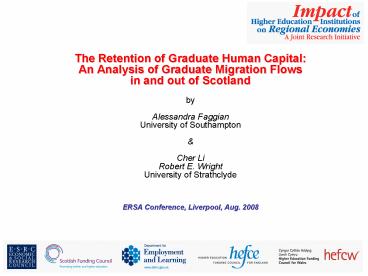The Retention of Graduate Human Capital: PowerPoint PPT Presentation
1 / 23
Title: The Retention of Graduate Human Capital:
1
- The Retention of Graduate Human Capital
- An Analysis of Graduate Migration Flows
- in and out of Scotland
- by
- Alessandra Faggian
- University of Southampton
- Cher Li
- Robert E. Wright
- University of Strathclyde
- ERSA Conference, Liverpool, Aug. 2008
2
- Introduction
- One of our objectives is to quantify the nature
of graduate labour market flows between the
countries and regions of GB - Why bother?
- Not a great deal is known about this.
- Regional focus Scotland, England and Wales
- export and import of graduates equally
interesting as the export and import of goods and
services - Information along these lines will be fed into
the CGE analysis
Slide 2/23
3
- Policy Relevance
- Concern with depopulation of rural and remote
regions of Scotland - Migration flows of students and graduate thought
to reinforce migration flows of general
population (north and west to the east) - Belief that building Higher and Further
Education institutions in rural and remote
regions will help reverse these trends
Slide 3/23
4
Data
- HESA (Higher Education Statistical Agency) is the
official agency for the collection, analysis and
dissemination of quantitative information about
higher education in the UK. - We use two datasets
- (1) Destinations of leavers from HEIs (DLHE)
- (2) Students in HEIs
- 12 waves available from 1994/95 to 2005/2006
- For current analysis, we focus on the most recent
wave (05/06) which includes information on around
2.4 million students and around 230,000 graduates.
Slide 4/23
5
A Brief Picture of HEIs in Scotland
20 HEIs 8 pre-92 Universities, 6 post-92
Universities and 7 Colleges (mainly clustered
around Glasgow and Edinburgh) Total number of
students in 05/06 215, 820 Number of students
went up by 44.9 between 94/95 and 05/06 (c.f.
national average 49.1 England 48.7).
Slide 5/23
6
Figure 1 students per 1,000 population, by
countries, 1994/95-2005/06
Scotland
UK average
Slide 6/23
7
Some descriptives
Slide 7/23
8
Slide 8/23
9
- The HESA data provide three key postal addresses
- Place of domicile
- Place of study
- Place of employment
- This allows us to identify 3 migration types
Slide 9/23
10
Stayers, Interregional Movers V.S. Leavers
Two different movements studied here
2. MEDIUM DISTANCE movements (interregional but
within country) interregional re-allocation of
skilled labour
- LONG DISTANCE movements (inter-country within GB)
brain drain or brain gain?
Leavers (L)
Interregional movers (I)
Slide 10/23
11
Breakdown of Migration Type for Scotland and the
Rest of GB
Slide 11/23
12
Model 2
Model 1
Stayers
Leavers (Scottish IN-migration)
Interregional Mover
Interregional Mover
Stayers
Leavers (Scottish OUT-migration)
Slide 12/23
13
- We model both OUT-flows (Model 1) and IN-flows
(Model 2) of graduates from and to Scotland using
a Multinomial Logit Model to identify both
problems of - Retention of graduates within Scotland
- (Model 1 stayers and interregional migrants)
- Attraction of graduates from outside Scotland
(Model 2 leavers from England and Wales)
Slide 13/23
14
MULTINOMIAL LOGIT MODELLING
jLeavers,Interregional Migrant, Stayer (base
category) qindividual identifier
Slide 14/23
15
Estimation Results (Model 1)
significant at 1 level, significant at 5
level, significant at 10 level
significant at 1 level, significant at 5
level, significant at 10 level
Slide 15/23
16
Plots of Odds Ratios and Discrete Change
Coefficients (Model 1)
Slide 16/23
17
Plots of Odds Ratios and Discrete Change
Coefficients (Model 1), cont
Slide 17/23
18
Estimation Results (Model 2)
significant at 1 level, significant at 5
level, significant at 10 level
Slide 18/23
19
Estimation Results (Model 2, cont)
significant at 1 level, significant at 5
level, significant at 10 level
Slide 19/23
20
Plots of Odds Ratios and Discrete Change
Coefficients (Model 2)
Slide 20/23
21
Plots of Odds Ratios and Discrete Change
Coefficients (Model 2), cont
Slide 21/23
22
Conclusions and Future Work
- Preliminary Conclusions
- Scotland is a net-loser of graduates in
absolute terms, but vis-à-vis elsewhere in GB, it
attracts the largest of high-quality graduates - Determinants of leavers similar from and to
Scotland male(), age(-), Asian(-),
postgraduate(), 1st/2.1(), science(),
combined(), ex-polytech(-), college(-), and
regional effects - Regional retention of human capital crucial
high-mobility graduates are of best quality
- Future work
- To incorporate more variables on regional
characteristics, e.g. quality of life,
social/economic environment - To use more disaggregated regions for analysis of
England/Wales, e.g. NUTS2 - Check for consistency of results over time and/or
time trends by incorporating longer time series
in the analysis
Slide 22/23
23
Thanks for your attention!
- For more details on this project, see
- http//ewds.strath.ac.uk/iheirei/Home.aspx
- Or email Cher.Li_at_strath.ac.uk

